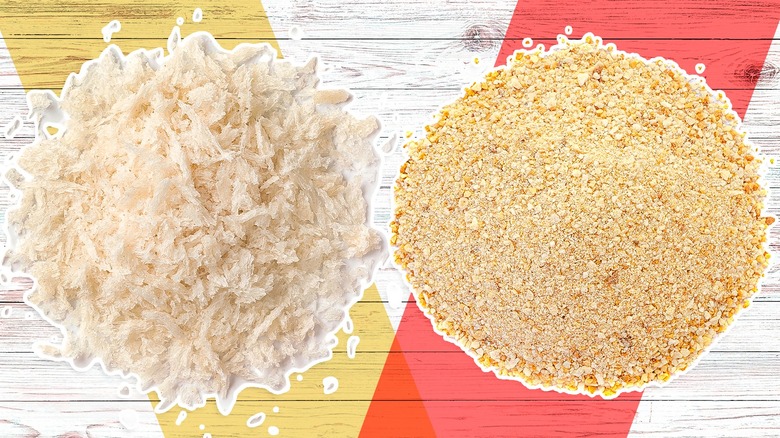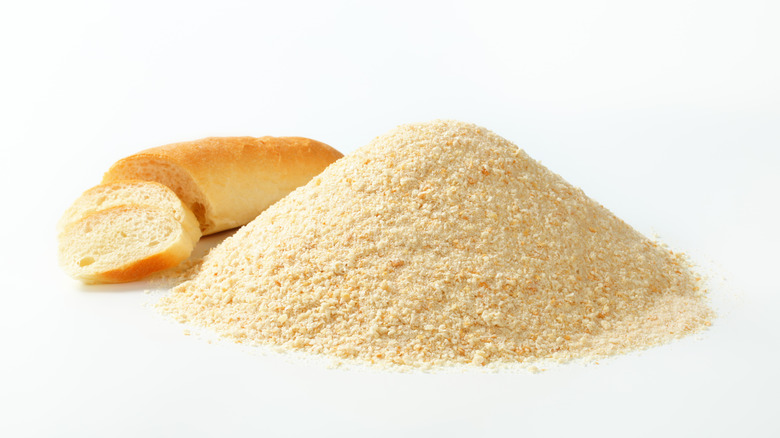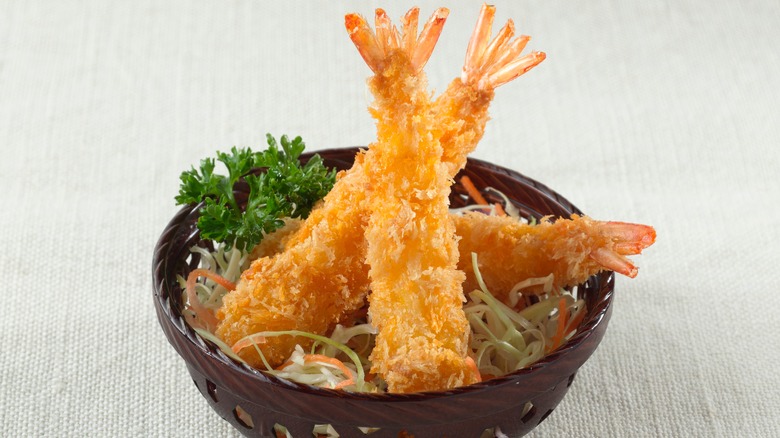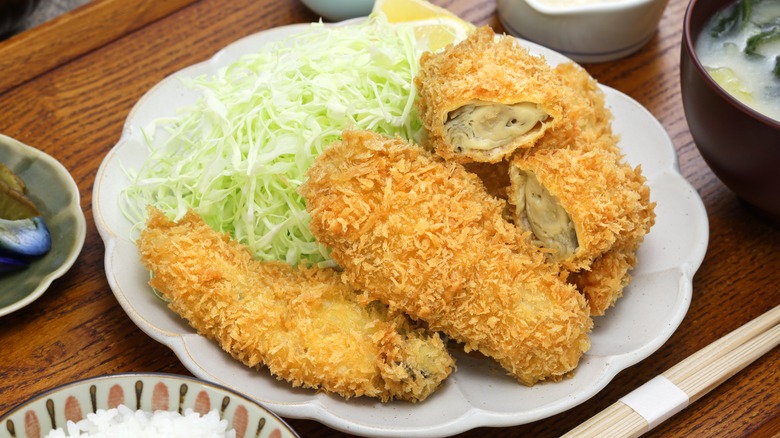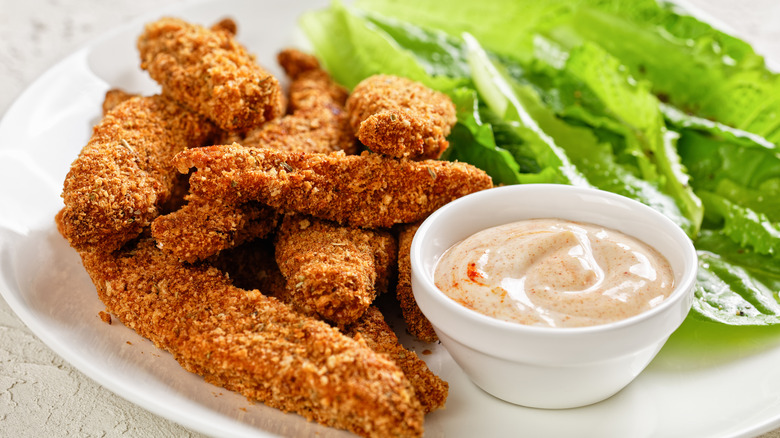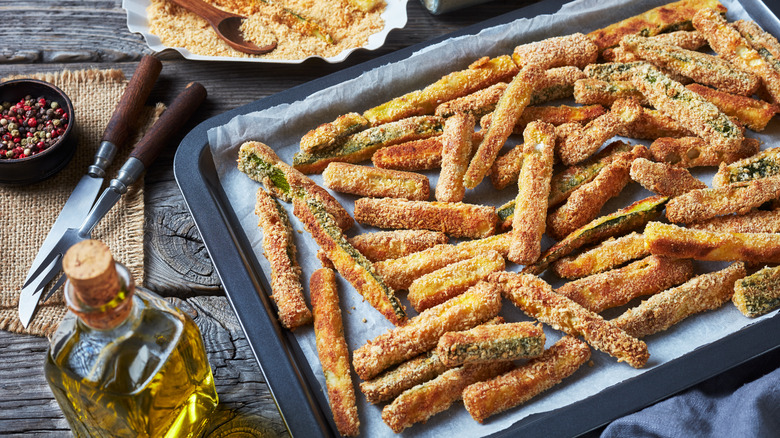The Real Difference Between Panko And Regular Bread Crumbs
Panko bread crumbs are known for being light and crisp — much more so than regular bread crumbs. Also known as "Japanese bread crumbs," the coating hails from Japan where it is used to coat or top many different dishes both baked and fried. You might be familiar with or already use panko bread crumbs at home to bread foods that you want to be extra crispy or to even taste like it's been fried.
But if you tend to use regular bread crumbs and haven't been pleased with the resulting texture, panko can add a satisfying crunch that your recipes might need. While both bread crumbs and panko can lend certain qualities to foods, each will provide different characteristics to dishes that the other can't. You might, however, be surprised to learn just how different the two types of breadcrumbs really are.
What actually are bread crumbs?
Bread crumbs are actually an umbrella term that encompasses a variety of different types of breads and crusts. In other words, panko is one specific type of bread crumb. Deliciously useful, bread crumbs can add texture and a crispy layer to meats, thicken and bind, and help retain moisture. It's definitely a staple ingredient that we recommend keeping your pantry stocked with.
You'll find pre-seasoned and plain bread crumbs at grocery stores, but you can always opt for homemade and transform a stale loaf into your own custom bread crumb blend. There is no shortage of recipes to spruce up. Try crunchifying mac n' cheese for a creamy bite or add breading to baked chicken for a crispy yet juicy mouthfeel. From stuffing to topping, bread crumbs are a surefire way to add some pizzazz to everyday recipes.
Nutritional differences between panko and bread crumbs
Given that panko bread crumbs and regular bread crumbs are both forms of dried bread, each type of coating, surprisingly, has some significant nutritional differences. According to Kikkoman Sales USA, Inc., per one-half cup of panko bread crumbs, there are 110 calories, 24 grams of carbohydrates, 2 grams of sugar, and 4 grams of protein. But one key nutritional difference between the two is that panko contains no fat or fiber.
Per one-half cup of regular bread crumbs, there are 168 calories, 30 grams of carbohydrates, nearly 3 grams of sugar, and roughly 6 grams of protein according to the Nutritionix food database. Though regular bread crumbs have more calories, carbs, sugar, and protein, they also contain 2 grams of fat and 2 grams of fiber. However, despite the different qualities and nutritional values, both types of bread crumbs can be used in similar dishes.
Both are crunchy but panko is crispier
Although both can be used interchangeably, there are several reasons why panko is a distinct type of breadcrumb, one being its consistency. Panko has a crispier texture that makes it perfect for crusting foods. If you're looking to add a crackly crunch, we suggest panko over bread crumbs, which, while also crunchy, have more chewiness. That subtle chew makes bread crumbs superior when blending into recipes and binding ingredients together. Bread crumbs are also thicker, which means that they absorb more oil.
Panko, on the other hand, is light, airy, and oil-resistant. In the kitchen, we suggest whipping out the panko for recipes like chicken katsu or panko fried shrimp, while bread crumbs are better employed for mouthwatering meatloaf or crave-worthy casserole. Besides consistency, pre-seasoned store-bought bread crumbs are great flavor boosters, too. While seasoned options exist, panko is traditionally neutral-flavored and mostly used for texture.
Panko is only made from one bread type
What separates panko from other varieties of breadcrumbs is how it is made. Whereas bread crumbs can be made from all sorts of bread, panko, in particular, is made with only flour, sugar, shortening, yeast, and salt and is traditionally cooked using an electrical current rather than heat. During the process, loaves of crustless white bread are steamed, dried, and turned into flakes, giving them an airy texture. You can distinguish panko from bread crumbs by its appearance, which is longer and shard-like. Fun Fact: "Pan" actually means bread, and "ko" translates to crumb in Japanese. There are several varieties of panko — raw (also known as nama), semi-dried, and dried — and different grind sizes that range from extra large to fine.
Bread crumbs absorb more oil than panko
As useful as bread crumbs can be, there are some potential pitfalls to watch out for. Adding a crispy coating of bread crumbs to foods is easy to overdo. A thick layer composed of flour and bread crumbs will absorb more oil, which will increase your caloric intake and potentially ruin the meal itself. Bread is a natural soaker-upper, so you must be mindful of how much you use. To reduce oil absorption, make sure that you only apply a thin layer of flour when breading.
The goal is to find a good balance between your desired crunch and the food that you are breading. You really only need one layer of coating to cover your food thoroughly. Another culprit behind oil absorption is oil temperature. Using a low temperature to fry gives foods a lighter color, makes them less flavorful, and increases their oil absorption. That said, if you're really worried about absorbing too much oil, we suggest opting for panko over bread crumbs.
Bread crumbs come in many flavors
From plain and Italian-seasoned to fresh and homemade, there are endless types of bread crumbs — especially when you experiment with different bread types. Besides texture, some breadcrumb varieties add flavor along with other benefits. "Plain" is one of the most common types; it's fine-textured, neutral-flavored, and is usually made from white bread that's been baked or toasted. It's similar to "fresh untoasted" bread crumbs, which, unlike plain, are made from grated fresh bread. Both are primarily used for texture, binding, and moisture absorption.
Then there are "fresh toasted" bread crumbs, which have everything their untoasted sibling has, along with a rich nutty flavor that compliments. Another popular variety is "Italian-seasoned" bread crumbs; it's a salty and savory boost for recipes. Beyond those common types, there are many ways to crust-ify your dishes. Try turmeric-flavored golden bread crumbs, cheesy crumbs, sweet and spicy, lemon pepper, and more.
You can also find seasoned panko options or lesser-known styles like pork panko, which is made from ground pork rinds and is a surefire way to add some crispy savoriness to recipes. Whichever you choose, be mindful because overusing seasoned bread crumbs can obscure the flavor of the food.
How to substitute bread crumbs for panko
While the differences between panko and regular bread crumbs will alter the dish, both can serve the general purpose you likely need, such as texture. Substituting one type of bread crumbs for the other is simple as you can typically use equal amounts of one for the other. However, many dishes that require bread crumbs call for as much as you like or need to cover a certain surface area. For example, in dishes where you are coating (like chicken fingers) or topping (such as casseroles), you can easily sprinkle as many panko or regular bread crumbs as you need. Also, remember that panko is both unseasoned and produces a crispier product than breadcrumbs, which will change the recipe. However, it's still better to substitute than forgoing them altogether.
